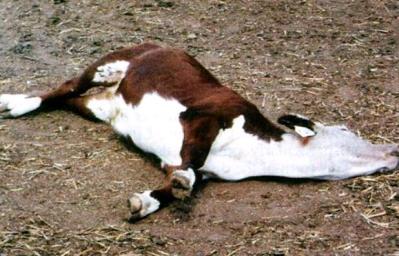Heartwater
Local names:
Samburu: ilmilo, sirgo / Rendile: sirgo / Borana: sirgo / Turkana: eidid, amili / Gabra:sirgo, qanno ree / Somali: gidhir, madhahta / Pokot: chemlei, chepripremot
Common names: cowdriosis
Description: Tick borne
Introduction
Hearwater is an infectious, non-contagious disease of ruminants, including some antelope species. It occurs in areas infested by Amblyomma ticks. These areas include Africa south of the equator, island countries off the east coast of Africa, including Madagascar, and some islands in the West Indies. Some animals may show no symptoms once infected and act as carriers. Indigenous African cattle breeds appear to be more resistant than European breeds.
Heratwater is caused by an organism formerly called Cowdria ruminantium, which has now been re-named Ehrlichia ruminantium.
Mode of spread
The Amblyomma ticks that spread Heartwater require a warm and relatively humid climate and bushy grass country for their development. Therefore the disease occurs in the rainy season.
Every year this disease destroys the calf and lamb crops of nomadic stockmen after their herds and flocks are moved from arid tick-free areas where lambing and calving has taken place, to tick-infested dry-season grazing.
Indigenous animals, both wild and domestic, living in the presence of infected Ambylomma ticks, often do not show symptoms when infected. Animals introduced from Heartwater-free areas, however, react severely. Calves under 3 weeks, and lambs under 1 week, possess a high innate resistance.
Some small mammals and ground birds, such as guinea-fowl , and reptiles such as leopard tortoises, may play a part in the maintenance of infection, by carrying Amblyomma ticks and by being hosts to Ehrlichia ruminantium.
Signs of Heartwater
Clinical Findings
The incubation period following exposure to infected ticks ranges from 7 to 28 days. Clinical reactions in the very young are mild and are often not observed. Reactions in older animals are acute. The course of the peracute disease is measured in hours, that of the acute in 3-6 days
- There is a sudden onset of fever, which remains high until shortly before death.
- In peracute cases, animals develop fever, excessive watering from the eyes, and convulsions.
- In the acute form, there is loss of appetite, fever, and signs of central nervous system disturbance.
- Affected animals chew constantly, lick their lips, and flick their eyelids while circling with a high-stepping gait, or standing with legs straddled and head lowered.
- Nervous signs worsen, until the stricken animals subside into sternal recumbency and then into lateral recumbency and die during a galloping convulsion.
- Diarrhoea is sometimes seen.
 |
| Heartwater: Lateral recumbancy with extended legs |
|
© USDA
|
Diagnosis
Diagnosis is based on:
- Movement of susceptible animals into a known Amblyomma infested area
- Clinical signs and
- Post mortem findings
- The organism targets and damages the walls of the blood vessels
- Increased vascular permeability results in fluid effusion into tissues and body cavities resulting in a fall in arterial pressure and general circulatory failure.
- In peracute and acute cases there is oedema of the lungs and brain, collection of fluid in the chest cavity, within the pericardial sac (hence the name Heartwater) and in the abdominal cavity.
- There is enlargement of the spleen, engorgement of the liver and occasionally haemorrhagic gastro-enteritis.
The brain oedema is responsible for the nervous signs so often observed. In order for a final diagnosis to be reached a veterinarian must be on hand to take brain crush smears to examine stained capillary endothelial cells for the dark purple colonies of Ehrlichia ruminantium.
Diseases with similar symptoms
- Cases in which there is sudden death must be differentiated from Anthrax and acute ECF, Plant poisoning and acute Redwater (Babesiosis).
- Nervous cases should be differentiated from tetanus, Rabies, Cerebral Anaplasmosis, Cerebral ECF and Strychnine poisoning used in baiting of dogs.
Prevention - Control - Treatment
Prevention and control
A carrier state persists for several weeks following recovery. Resistance persists for longer - from 6 months to 4 years. Reinfection can occur but is usually clinically inapparent although subacute signs can occasionally occur.
- Dipping or spraying with acaricides at weekly intervals will reduce the incidence of the disease.
- Preventing the introduction of Amblyomma infested stock or fodder into clean areas. The excessive reduction of tick numbers, however, interferes with the maintenance of adequate immunity through regular field challenge in endemic areas and may result in heavy losses.
- There is as yet no widely effective and safe vaccine against Heartwater. However, an "infection and treatment" method with infected sheep blood or a suspension of infected nymphal ticks is used. This is injected iv (intravenous) and severe post-immunisation reactions are controlled by the administration of tetracyclines at the onset of fever, and then every 12 hours until the fever decreases.
In areas where the disease is endemic adult animals are normally immune and hence it is usually only necessary to immunise the annual calf of lamb crop. Animals derived from Heartwater free areas should be immunised.
Treatment
To be effective treatment must be carried out in the early stages of the disease.
- Oxytetracycline at 10mg/kg or doxycycline at 2 mg/kg are usually effective.
- In sheep, goats and susceptible cattle breeds, a higher dose (10-20 mg/kg) of oxytetracycline may be required, especially if treatment begins late during the feverish reaction or after other clinical signs appear. In such cases the first treatment should be given intra veinously.
- A second and third treatment may be required before the fever abates, or a second injection intra muscularly with a long-acting oxytetracycline formulation may be given.
- In animals showing nervous signs diuretics and non-steroidal anti-inflammatory drugs are indicated.
